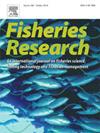锚定鱼群聚集装置阵列中的金枪鱼聚集动力学
IF 2.3
2区 农林科学
Q2 FISHERIES
引用次数: 0
摘要
热带金枪鱼是世界上最具商业价值的鱼类之一。发展中国家的许多工业和手工渔业利用人工漂浮结构(鱼类聚集装置或FADs)来对付它们。尽管渔民对金枪鱼与这种结构的联想行为是众所周知的,但它们如何与fad相互作用的知识仍然是零碎的。利用附着在FADs上的回声测深浮标数据,我们在两年(2017-2018年)期间(世界主要金枪鱼捕捞国之一)评估了马尔代夫一系列锚定FADs (aFADs)内的金枪鱼聚集动态。随机森林模型对金枪鱼存在和不存在的预测在与半定量日志数据进行评估时显示出良好的准确性(78 %),但与电话调查数据进行评估时表现不佳(~ 49 %)。这两年的入住率都超过60% %,每年4月达到80% %以上的峰值。这表明FAD的密度低到足以让金枪鱼持续使用,或者种群大到足以维持占用,或者两者兼而有之。聚合体连续停留时间(aCRT)平均为7.96 d,连续缺席时间(aCAT)平均为3.89 d。这两个指标都遵循指数分布,表明潜在的生物过程与时间无关且无记忆。空间自相关显示,尽管有一些局部影响,但afad之间的金枪鱼缺失存在部分相关性,这支持了之前马尔代夫afad不作为一个网络发挥作用的发现。这些发现突出了回声测深浮标数据的价值,提供了可靠的聚合指标和对金枪鱼行为的洞察,可以为渔业管理提供信息。本文章由计算机程序翻译,如有差异,请以英文原文为准。
Tuna aggregation dynamics in an array of anchored fish aggregating devices (AFADs)
Tropical tuna species are among the world's most commercially important fish. Numerous industrial and artisanal fisheries in developing countries target them using artificial floating structures (Fish Aggregating Devices or FADs). Although tunas' associative behaviour with such structures is well known to fishers, knowledge of how they interact with FADs remains fragmentary. Using echo-sounder buoy data attached to FADs, we assessed tuna aggregation dynamics within an array of anchored FADs (aFADs) in the Maldives—one of the world's leading tuna fishing nations—over two years (2017–2018). Predictions of tuna presence and absence from a random forest model showed good accuracy when evaluated against semi-quantitative logbook data (78 %) but performed poorly with phone survey data (∼49 %). Occupancy at aFADs exceeded 60 % in both years, peaking above 80 % each April. This suggests FAD density is low enough for continuous use by tuna, the population is large enough to sustain occupancy, or both. Aggregations’ continuous residence time (aCRT) averaged 7.96 days, while continuous absence times (aCAT) averaged 3.89 days. Both metrics followed exponential distributions, suggesting the underlying biological process is time-independent and memoryless. Spatial autocorrelation showed partial correlation in tuna absence among aFADs, despite some local effects, supporting previous findings that aFADs in the Maldives do not function as a network. These findings highlight the value of echo-sounder buoy data, offering robust aggregation metrics and insights into tuna behaviour that could inform fisheries management.
求助全文
通过发布文献求助,成功后即可免费获取论文全文。
去求助
来源期刊

Fisheries Research
农林科学-渔业
CiteScore
4.50
自引率
16.70%
发文量
294
审稿时长
15 weeks
期刊介绍:
This journal provides an international forum for the publication of papers in the areas of fisheries science, fishing technology, fisheries management and relevant socio-economics. The scope covers fisheries in salt, brackish and freshwater systems, and all aspects of associated ecology, environmental aspects of fisheries, and economics. Both theoretical and practical papers are acceptable, including laboratory and field experimental studies relevant to fisheries. Papers on the conservation of exploitable living resources are welcome. Review and Viewpoint articles are also published. As the specified areas inevitably impinge on and interrelate with each other, the approach of the journal is multidisciplinary, and authors are encouraged to emphasise the relevance of their own work to that of other disciplines. The journal is intended for fisheries scientists, biological oceanographers, gear technologists, economists, managers, administrators, policy makers and legislators.
 求助内容:
求助内容: 应助结果提醒方式:
应助结果提醒方式:


